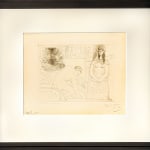




Pablo Picasso
Peintre Ramassant son Pinceau, Avec un Modèle - Au Turban, 1927-1930
Etching on wove paper
7 1/2 × 10 1/2 × 1/2 in
19.1 × 26.7 × 1.3 cm
19.1 × 26.7 × 1.3 cm
Edition of 99
Hand signed in pencil, lower right.
Copyright The Artist
Further images
Pablo Picasso’s 'Peintre Ramassant son Pinceau, Avec un Modèle – Au Turban' is a powerful and intimate etching that showcases his ongoing fascination with the relationship between the artist and...
Pablo Picasso’s "Peintre Ramassant son Pinceau, Avec un Modèle – Au Turban" is a powerful and intimate etching that showcases his ongoing fascination with the relationship between the artist and his subject, while also revealing his dynamic and experimental approach to form and space.
The title of the work translates to "Painter Picking Up His Brush, with a Model – Wearing a Turban", and it succinctly conveys the core elements of the image. The scene captures a moment of artistic creation, where the artist (depicted as a simplified, almost abstract figure) is in the act of retrieving his brush, while his model, a woman wearing a turban, stands nearby. This interaction is not just a literal moment, but also a symbolic exploration of the relationship between the artist and the muse, as well as the fluid boundaries between observer and creator.
Hand signed, lower right corner.Edition of 99From Le Chef-d'OEuvre Inconnu (B. 88; Ba. 129; see C. books 20)
The title of the work translates to "Painter Picking Up His Brush, with a Model – Wearing a Turban", and it succinctly conveys the core elements of the image. The scene captures a moment of artistic creation, where the artist (depicted as a simplified, almost abstract figure) is in the act of retrieving his brush, while his model, a woman wearing a turban, stands nearby. This interaction is not just a literal moment, but also a symbolic exploration of the relationship between the artist and the muse, as well as the fluid boundaries between observer and creator.
Hand signed, lower right corner.Edition of 99From Le Chef-d'OEuvre Inconnu (B. 88; Ba. 129; see C. books 20)




